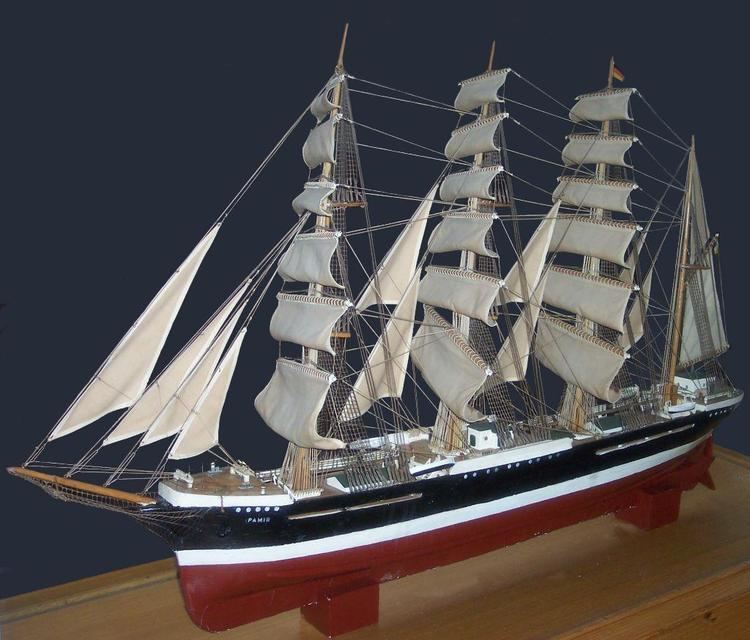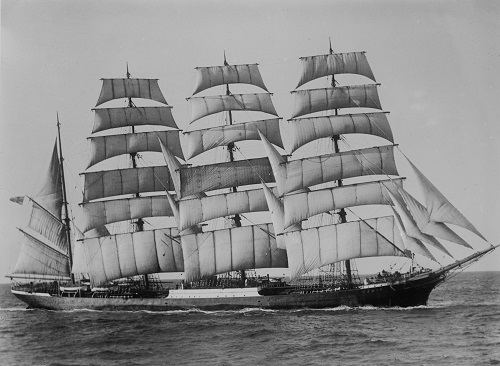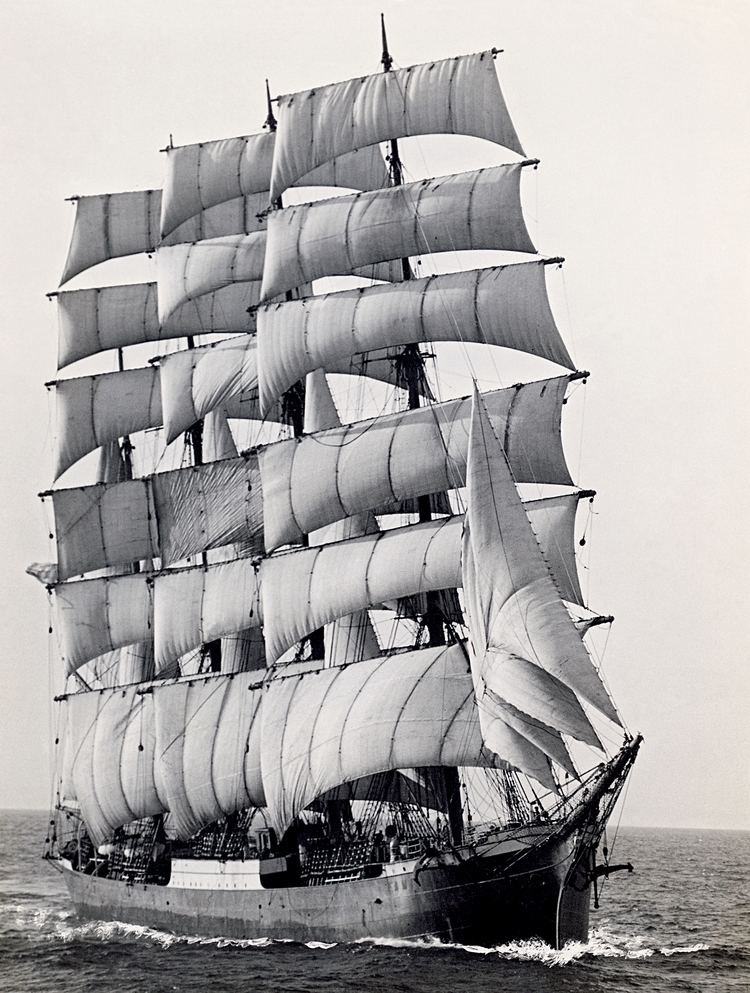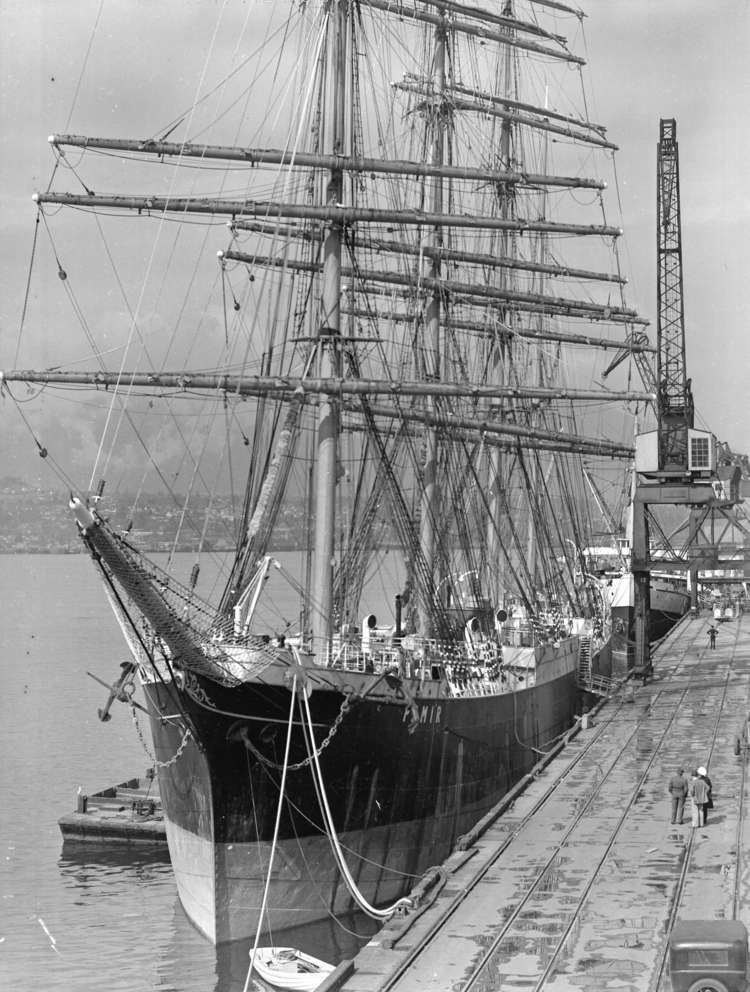Name Pamir Acquired Erikson Line, 1948 Length 96 m Builder Blohm + Voss | Acquired Erikson Line, 1931 Launched 29 July 1905 Beam 14 m | |
 | ||
Acquired 1920, as war reparations Acquired Seized as prize of war, 3 August 1941 | ||
Pamir, a four-masted barque, was one of the famous Flying P-Liner sailing ships of the German shipping company F. Laeisz. She was the last commercial sailing ship to round Cape Horn, in 1949. By 1957 she had been outmoded by modern bulk carriers and could not operate at a profit. Her shipping consortium's inability to finance much-needed repairs or to recruit sufficient sail-trained officers caused severe technical difficulties. On 21 September 1957 she was caught in Hurricane Carrie and sank off the Azores, with only six survivors rescued after an extensive search.
Contents
- Early days and World War I
- World War II and beyond
- Last voyage
- False coverage
- Insurance
- In media
- References

Early days and World War I
She was built at the Blohm & Voss shipyards in Hamburg, launched on 29 July 1905. She had a steel hull & tonnage of 3,020 GRT (2,777 net). She had an overall length of 114.5 m (375 ft), a beam of about 14 m (46 ft) and a draught of 7.25 m (23.5 ft). Three masts stood 51.2 m (168 ft) above deck and the main yard was 28 m (92 ft) wide. She carried 3,800 m² (40,900 ft²) of sails and could reach a top speed of 16 knots (30 km/h). Her regular cruise speed was around 8-9 knots.

She was the fifth of ten near-sister ships. She was commissioned on 18 October 1905 and used by the Laeisz company in the South American nitrate trade. By 1914 she had made eight voyages to Chile, taking between 64 and about 70 days for a one-way trip from Hamburg to Valparaíso or Iquique, the foremost Chilean nitrate ports at the time. During World War I she stayed in Santa Cruz de la Palma port in La Palma Island, Canary Islands between October 1914 until March 1920. Due to post war conditions she did not return to Hamburg until 17 March 1920 from Santa Cruz de la Palma.

In the same year she was handed over to Italy as war reparation. On 15 July 1920, she left Hamburg via Rotterdam to Naples towed by tugs. The Italian government was unable to find a deep-water sailing ship crew, so she was laid up near Castellamare in the Gulf of Naples.

In 1924 the F. Laeisz Company bought her back for £7,000 and put her into service in the nitrate trade again. Laeisz sold her in 1931 to the Finnish shipping company of Gustaf Erikson, which used her in the Australian wheat trade.
World War II and beyond

During World War II Pamir was seized as a prize of war by the New Zealand government on 3 August 1941 while in port at Wellington. Ten commercial voyages were made under the New Zealand flag: five to San Francisco, three to Vancouver, one to Sydney and her last voyage across the Tasman from Sydney to Wellington carrying 2700 tons of cement and 400 tons of nail wire. Weathering a storm during the last Tasman voyage is described in detail by one of the mates, Andrew Keyworth, in a letter never posted.
She escaped the war unscathed despite a close call in 1943 when a Japanese submarine was spotted. Evidently as a fast-moving barque under a strong and fair wind, she did not interest the submarine's commander. After the war she made one voyage from Wellington via Cape Horn to London, then Antwerp to Auckland and Wellington in 1948.
She was returned to the Erikson Line on 12 November 1948 at Wellington and sailed to Port Victoria on Spencer Gulf to load Australian grain. On her 128-day journey to Falmouth she was the last windjammer carrying a commercial load around Cape Horn, on 11 July 1949.
Gustaf Erikson had died in 1947. His son Edgar found he could no longer operate her (or Passat) at a profit, primarily due to changing regulations and union contracts governing employment aboard ships; the traditional 2-watch system on sailing ships was replaced by the 3-watch system in use on motor-ships, requiring more crew.
In March 1951, Belgian shipbreakers paid £40,000 for her and Passat. As she was being towed to Antwerp, German shipowner Heinz Schliewen, who had sailed on her in the late 1920s, bought her (and Passat, thus often erroneously referred to as a sister ship). The ships were modernized with refurbished quarters to accommodate merchant marine trainees, fitted with an auxiliary engine, a refrigeration system for the galleys (precluding the need to carry live animals for fresh meat), modern communications equipment and water ballast tanks. Her first trip was to Brazil in 1952 with cement, to return to Germany with iron ore. Early in the outbound voyage the propeller dropped off, "much to the satisfaction of the sail-favoring crew if not the owner." The enterprise went briefly bankrupt but was bought by a new consortium of 40 German shipowners. For the next five years the ships continued to sail between Europe and the east coast of South America, but not around Cape Horn. They were used as cargo-carrying school ships, primarily to Argentina. Although the German public supported the concept as maritime symbols and sources of national pride, the economic realities of the post-war years placed restraints on the operation. The ships were no longer profitable as freight haulers, and Pamir had increasing technical problems such as leaking decks and serious corrosion. The consortium was unable to get sufficient increased funding from German governments or contributions from shipping companies or public donations, and thus let both vessels deteriorate.
Last voyage
Due to ill health, her regular captain, Hermann Eggers, had been replaced by Captain Johannes Diebitsch, who had sailed on her as a young seaman and had commanded sail-training ships, but had little experience as master of cargo-carrying sailing ships. His first officer, Rolf Köhler, was only 29 at the time, and wrote that he was "getting thin with anger" over the state of the ship and that he was intending to quit the ship's company after arriving home from the next voyage. Captain Diebitsch was criticized for being a harsh and inflexible officer.
On 10 August 1957 she left Buenos Aires for Hamburg with a crew of 86, including 52 cadets. Her cargo of 3,780 tons of barley was stored loose in the holds and ballast tanks, secured by 255 tons in sacks on top of the loose grain. Records indicate that this was one of the major mistakes implicated in the sinking – she had been held up by a dockworkers' strike, and Diebitsch, under severe pressure to sail, decided to let the trimming (the correct storage of loose cargo so that it does not shift in the hold) be done by his own untrained crew. It was later found that he also had the ballast tank filled with barley. Even though testing of the roll period (the time the ship took to right itself after load transfers) showed that she was dangerously unsafe, Diebitsch decided to sail.
On the morning of 21 September 1957 she was caught in Hurricane Carrie before shortening sails. It was later considered that because the radio officer had also been given substantial administrative tasks (to save the money required for another officer's position), he had likely not received any of the radio storm warnings. She had also not responded to radio hails by ships that had sighted her earlier in the voyage. She soon listed severely to port in the sudden storm. As hatchways and other openings were not closed at once, they probably allowed considerable amounts of water to enter, as found by the commission who examined the probable causes of the sinking. The shipping company's lawyer at the investigation claimed that the water entered her due to a leak. According to the commission, the water caused her to list further and the grain to shift, which aggravated the list.
The captain did not order the flooding of her grain-filled ballast tanks, which would have helped her to right herself. Once she listed severely, the lifeboats could not be deployed because her port side was under water and her starboard side was raised to an angle that did not allow use of the boats.
She sent distress signals before capsizing at 13:03 local time, and sinking after drifting keel-up for 30 minutes in the middle of the Atlantic 600 nautical miles (1,100 km) west-southwest of the Azores at position 35°57′N 40°20′W. Three damaged lifeboats that had come loose before or during the capsizing and the only liferaft that had been deployed were drifting nearby. None contained any provisions or working distress signal rockets. Many sharks were later seen near the position.
A nine-day search for survivors was organized by the United States Coast Guard cutter USCGC Absecon (WAVP-374), but only four crewmen and two cadets were rescued alive, from two of the lifeboats. It was reported that many of the 86 men aboard had managed to reach the boats, but most died in the next three days. As none of the officers nor the captain survived, the reasons for the capsizing remained uncertain.
The sinking made headlines around the world; it was a national tragedy in Germany.
False coverage
The sinking received extensive but not always accurate press coverage. For example, The New Zealand Herald reported the following fabrication mixing the real event with imagined details, supposedly directly based on the survivor "Gunter Hasselback" (his real name was Günter Haselbach):
‘The Loss of the Pamir’Last of the ‘P’ Line“Overwhelmed in a hurricane off the Azores on September 21, 1957, - complement of about 80 crew and training cadets – 5 survivors picked up on Tuesday, 24th. Survivors tell of how terror struck into the hearts of the naval cadets in the Pamir when huge waves tossed her around like a shuttle cock. Her cargo of wheat shifted and she took on a 45 degree list. Her crew fought to right her and to calm the cadets who were making their first sea voyage, but hysteria gripped them. The captain (Diebitsch) led the cadets in prayer but it was impossible to calm them. He ordered them away in three boats with three experienced hands in each. As the boats were launched they were caught by the mountainous waves and sent hurtling hundreds of feet away from the ship. The boats had hardly been launched when the masts snapped and her sails were blown away. The pounding of the seas and the drag of the masts and rigging over the side, heeled the ship over further and further. It was now impossible to keep the Pamir’s bows head into the wind – she was lying broadside on. There was no time to send another SOS (aerials were down) – the end was here. In the trough of a giant wave she rolled right over and we last saw her was her bottom up and going down by the bow like a submarine slowly diving. The few men who were still on board when she capsized were struggling in the water. I don’t know how we got away but it seemed to me that our lifeboat was the only one successfully launched. We had no flares or smoke signals that worked. I could see nothing of the three boats in which the cadets had been put out from the ship. Seventeen of the men in my boat were washed overboard in the hurricane while rescue aircraft were flying overhead above the storm. Three others, screaming like demons, jumped overboard into the sea on Monday afternoon. I was too weak to stop them. If you had not found me on Tuesday, I would have done the same thing myself.”Gunter HasselbackThe facts as reported by the survivors and established by the "Seeamt Lübeck", the German authority that investigated the sinking, are that Haselbach was the only survivor rescued from the second lifeboat, not one of the five survivors found together as the article suggests; Pamir had a cargo of barley, not wheat. It is not certain when the cargo shifted; the official opinion of the investigation indicated it was early in the storm, but others have suggested it shifted only at the very end; the cadets had already gone from Hamburg to Buenos Aires before they started the return trip.
The survivors reported that crew and cadets stayed very calm until close to the loss of the ship because the ship was not believed to be in difficulties – cadets were still taking photographs, and supposedly some complained when ordered to put on life jackets. Even at the very end, there was no panic. She was not going head into the wind at any time, and her engine was not used.
She was mounted more and more to the wind, with waves, more from abaft the beam (behind), hitting roughly from the side. Radio contact was maintained until the end. She sent her last audible SOS call at 12:54 and an indecipherable one at 13:03; she was capsizing around this time. At least one lifeboat broke free before the capsize; others detached briefly before or during the capsizing and sinking. Nobody boarded a lifeboat before she capsized, and nobody jumped overboard: when she capsized, all 86 men were still on board.
Her masts did not break nor did any yards or anything else fall down, so nothing was dragging to the side. Some sails were left until they were blown out, but others were shortened or cut off by the crew; the headsail had to be cut with knives before it would blow out. When she sank, she still had set about a third of the mizzen sail and some tarpaulin in the shrouds of the mizzen mast.
The boat that Haselbach reached was badly damaged (as were the other two that were salvaged) and almost entirely submerged when he was rescued. Nothing indicates that four boats were manned - the existence of a third manned boat is only assumed, mostly on grounds of survivors' reports of seeing flares one night. Of the 20 or 22 men who were on Haselbach's boat, ten were still on board 24 hours before he was rescued, after the hurricane dissipated. The rescue aircraft could be deployed only after the storm had calmed down. The official documents, including a report by Haselbach during the hours after he was found, say nothing about people screaming when they left the lifeboats.
The Pamir was not last of the ‘P’ Line, as the newspaper's subtitle suggests. The Passat was still in service, and other ‘P’ Liners still existed but not under sail, including the Kruzenshtern (ex Padua, the only ‘P’ Liner still under sail), the Peking and the Pommern.
Some accounts of the loss, mostly online, are based on earlier false coverage.
Insurance
In a tragically ironic twist of fate, her last voyage was the only one in her school ship career during which she made a profit, as the insurance sum of about 2.2 million Deutsche Mark was sufficient to cover the company losses for that year. While there was no indication that this was the intention of the consortium, which was never legally blamed for the sinking, it was considered much later by researchers that through its neglect it was at least strongly implicated in the loss.
